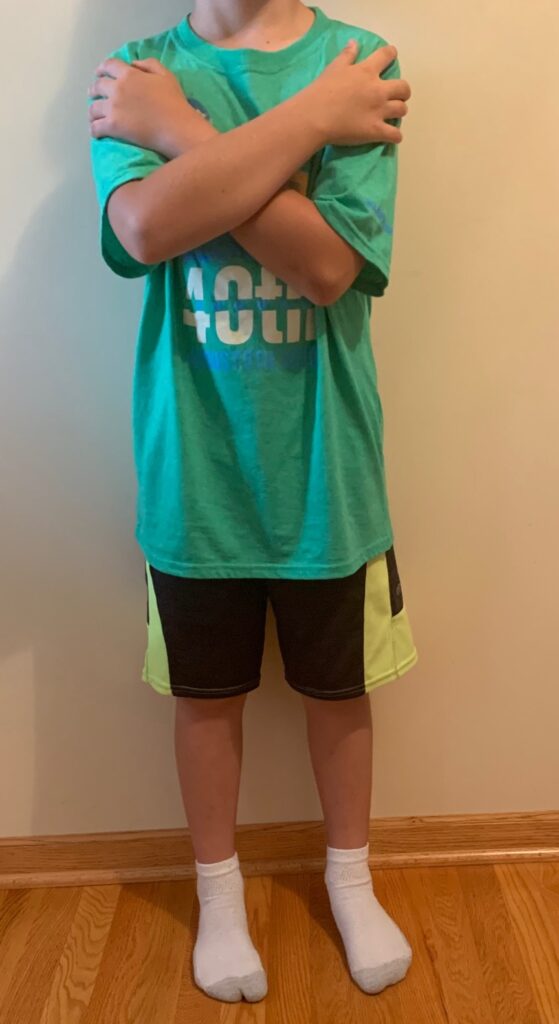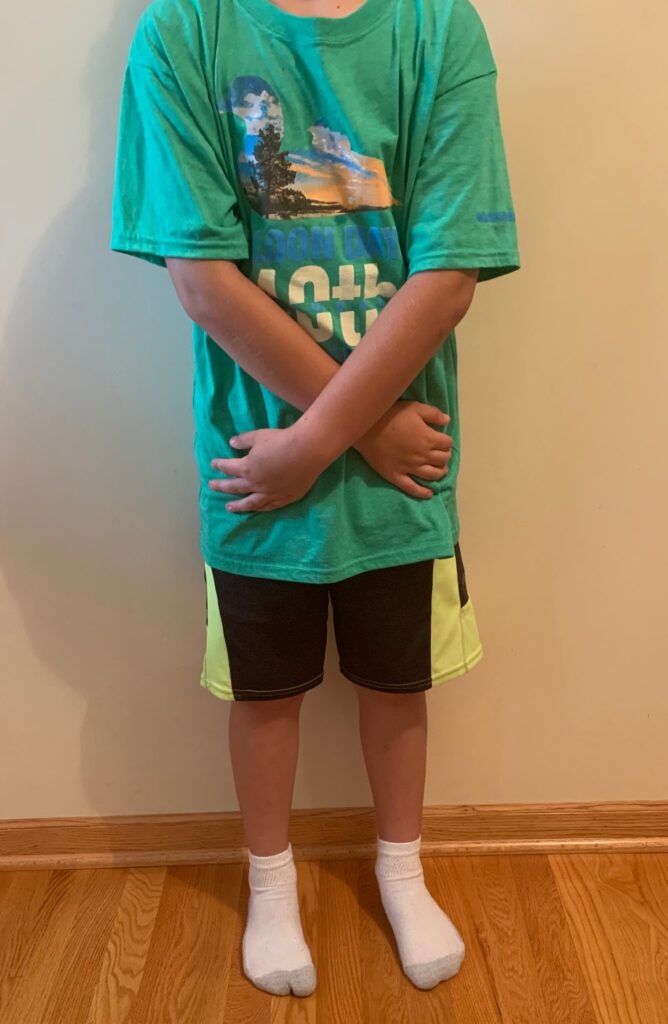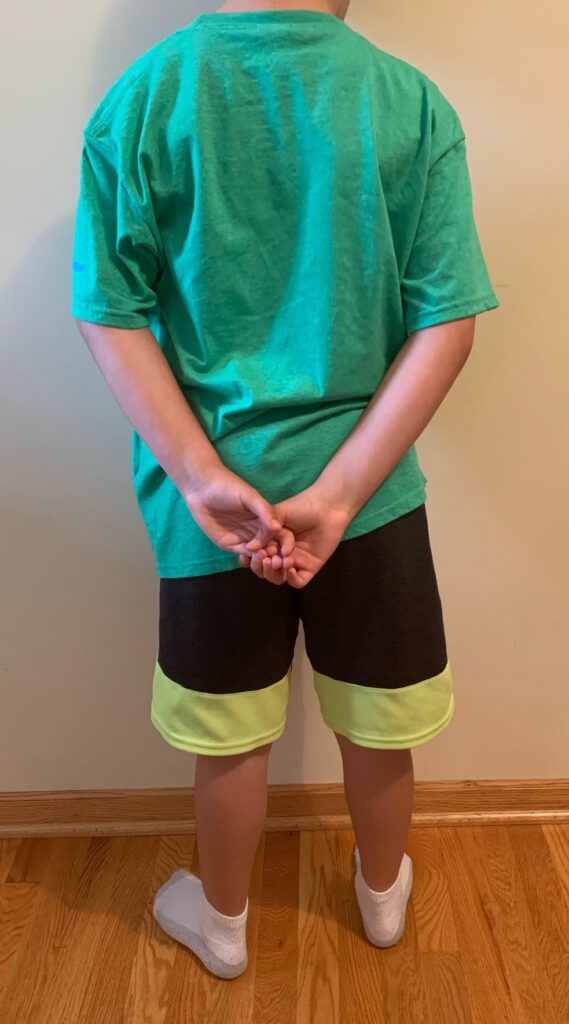It’s a Matter of Safety: What Kinds of Touch are Okay?
This article helps parents and caregivers teach blind and low-vision children about safe and unsafe touching. Often, people who are blind get used to being touched as part of daily life. For example, to show them something, someone might guide their hand to an object.
People also might need to touch them to guide them through different places. So, in their day-to-day life, at home or school, touch is a common way for blind people to interact with their world. But this can make it hard for young blind children to know what kind of touching is okay and what isn’t. That’s why they need clear teaching about this.
For very young blind children, or those with additional challenges, there’s a method called the “Swedish apron.” (Kapperman & Kelly, 2013:Kelly & Kapperman, 2019). This involves teaching the child to cross their arms over their chest, with each hand on the opposite shoulder.
Swedish Apron
There’s a photo showing this in Picture 1 below. This technique helps explain which body parts are okay to touch and which aren’t.
 Picture 1. This picture is of a forward-facing boy from the shoulders down placing his arms across his or her chest with each hand touching the opposite shoulder. The boy is clothed wearing a t-shirt, shorts, and socks in this picture.
Picture 1. This picture is of a forward-facing boy from the shoulders down placing his arms across his or her chest with each hand touching the opposite shoulder. The boy is clothed wearing a t-shirt, shorts, and socks in this picture.
Then, instruct the youngster to move their arms downward across the front of his or her body moving downward and across the stomach and pelvic area as shown in Picture 2 below.
 Picture 2. This picture is of a forward-facing boy from the shoulders down placing his arms across his stomach and pelvic area with each hand touching the opposite side of his body. The boy is clothed wearing a t-shirt, shorts, and socks in this picture.
Picture 2. This picture is of a forward-facing boy from the shoulders down placing his arms across his stomach and pelvic area with each hand touching the opposite side of his body. The boy is clothed wearing a t-shirt, shorts, and socks in this picture.
Following this movement, the youngster should move their hands across the upper thighs and back across the thighs to the buttocks clasping the hands together at the top of the buttocks. The hands should touch at the upper portion of the buttocks as shown in Picture 3 below.
 Picture 3. This picture is of the backside of a boy from the shoulders down. The child’s hands are clasped together at the upper portion of the buttocks. The boy is clothed wearing a t-shirt, shorts, and socks in this picture.
Picture 3. This picture is of the backside of a boy from the shoulders down. The child’s hands are clasped together at the upper portion of the buttocks. The boy is clothed wearing a t-shirt, shorts, and socks in this picture.
When Arms Cross
The main idea is that the body parts where the child’s hands and arms touch while crossing them are usually off-limits. Others shouldn’t touch these areas without the child’s permission. These include the chest, stomach, pelvic area, and buttocks. Using the child’s own body to show which parts shouldn’t be touched is what this method is about. So, the parts that are okay for others to touch include the legs, feet, arms, hands, neck, and head.
Parents and caregivers can emphasize that these portions of the body can be appropriately touched by others during the routine of the day, but only under very “special” circumstances the other parts of the body are off limits for most individuals to touch without some special reason.
Exceptions to the rules regarding touching apply to mothers and other trusted caregivers. There are, of course, many situations in which the body parts designated as off-limits must be touched by trusted caregivers. Exceptions to the rule must be described to the child.
When to say “No”
It’s important to teach your child to say no if someone tries to touch them in a bad way, especially when trusted adults aren’t around. This could happen with other adults they meet when they’re not with a caregiver. Tell your child it’s okay to tell someone not to touch them. If someone doesn’t stop, they should be more firm. Teach them to say they will tell their mom, dad, or another trusted adult.
There are ways to teach kids about safe and unsafe touching. Besides the Swedish apron, dolls can be a helpful tool. They can show which body parts are okay to touch and which are not.
For instance, using a doll, a caregiver can explain that touching someone in their private areas, like the genital area, is not allowed. The caregiver can guide the child’s hand to the doll’s private area to make this clear. They can also point out other off-limits areas, like the buttocks, in the same way.
Ask For Permission
A well-accepted approach for touching blind individuals of all ages that should be used during the general course of business of the day is for the individual who wishes to touch the person who is blind should ask for permission. This is a common approach. It has two salutary effects. First of all, it indicates that the person who is blind has control over their body and others need to ask for permission to touch them. Thus, they must give permission to be touched. An example of this type of interaction might occur when a teacher wishes to show the youngster an object. The teacher may ask, “May I put your hands on the object?” This allows the child to have control in this situation. It drives home the point that they have control over their body and others do not.
Imagine your child is learning to use something new, like a microwave with braille labels. They need to move their hands and fingers in a certain way. The teacher might guide their fingers to the right braille labels. This helps them understand each control’s purpose faster. It’s better than letting them try to find the controls on their own.
Understanding When it is Necessary
Sometimes, it’s okay for certain off-limits areas to be touched. This can happen during a doctor’s or nurse’s check-up. It’s important to tell your child that this is okay. It’s part of getting the care they need. Make sure your child knows that a parent or a trusted person will be there during the check-up. Let them know that in these special cases, the normal rules about touching don’t apply.
Protecting Youngsters Early
The advice in this article is to keep blind or low-vision kids safe from harm. Sadly, some people see those who are blind as easy targets because they can’t see. These people might think they won’t be caught. They might also wrongly believe that blind people are less capable, making them easier to victimize. Because of these risks, it’s important for blind individuals to learn how to defend themselves as best as they can. This helps them stay safe and protect themselves from those with bad intentions.
With regard to youngsters who are blind with or without additional challenges, the instructions that the current authors have described above are, unfortunately, necessary for the protection of the children.
Be In the Know
Unfortunately, evidence shows that the majority of abuse cases are perpetrated by individuals who are known to the children. (Crosse, et.al, 1994; Kapperman, Brown-Ogilvie, Yesaitis, & Peskin, 2014).) Obviously, that abuse takes place out of sight of the caregivers who have responsibility for the child or children. Because of this most unfortunate situation, we believe that parents or concerned caregivers should arm the youngsters with the capability of defending themselves against the unwelcomed touching of potential abusers before the unwarranted actions reach levels that are completely inappropriate. The instructions described above may be used to good advantage in the prevention of abuse by individuals who may be prone to that type of inappropriate behavior.
Typically sighted children have the opportunity for incidental learning when they observe what makes people physically different. It is important to take the time to teach young children the appropriate language for body parts, how bodies are unique and different from each other and how bodies change from a child to an adult. You may find these tips helpful when talking with your child about their body, Knowledge is Power for Children with Blindness or Low Vision: How Knowing Your Own Body Keeps You Safe.
References
Crosse, S. B., & Others. (1994). A report on the maltreatment of children with disabilities. Washington, DC: National Center on Child Abuse and Neglect.
Kapperman, G., Brown-Ogilvie, T., Yesaitis, J., & Peskin, A. (2014). Prevention of sexual assault against children who are visually impaired. Division on Visual Impairments Quarterly, 59(2),33-37.
Kapperman, G., & Kelly, S. M. (2013). Sex education instruction for students who are visually impaired: Recommendations to guide practitioners. Journal of Visual Impairment & Blindness, 107,226-230.
Kelly, S. & Kapperman, G. (2019).Sex Education. In Health Education for Students with Visual Impairments: A Guidebook for Teachers. Louisville, KY: American Printing House for the Blind.